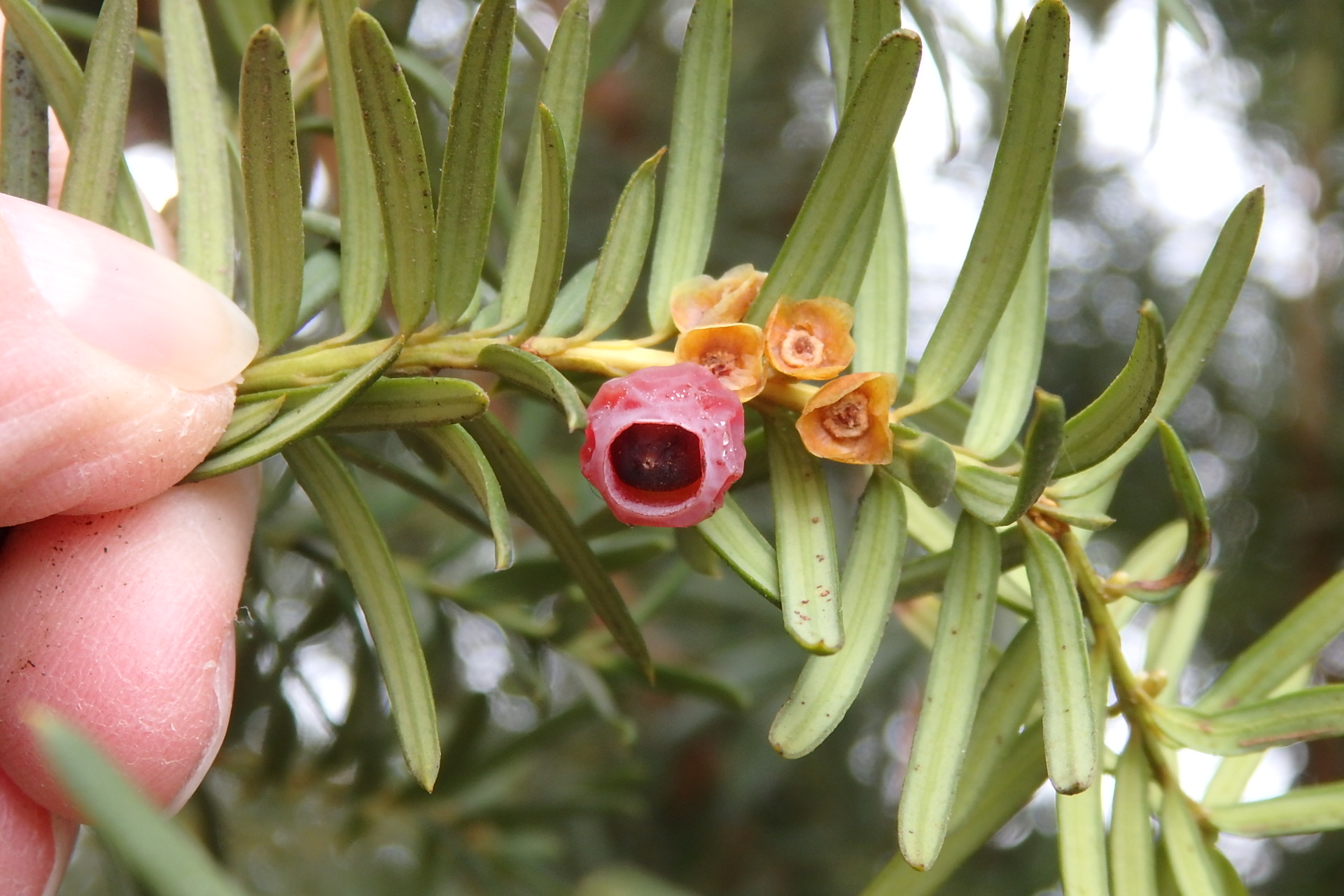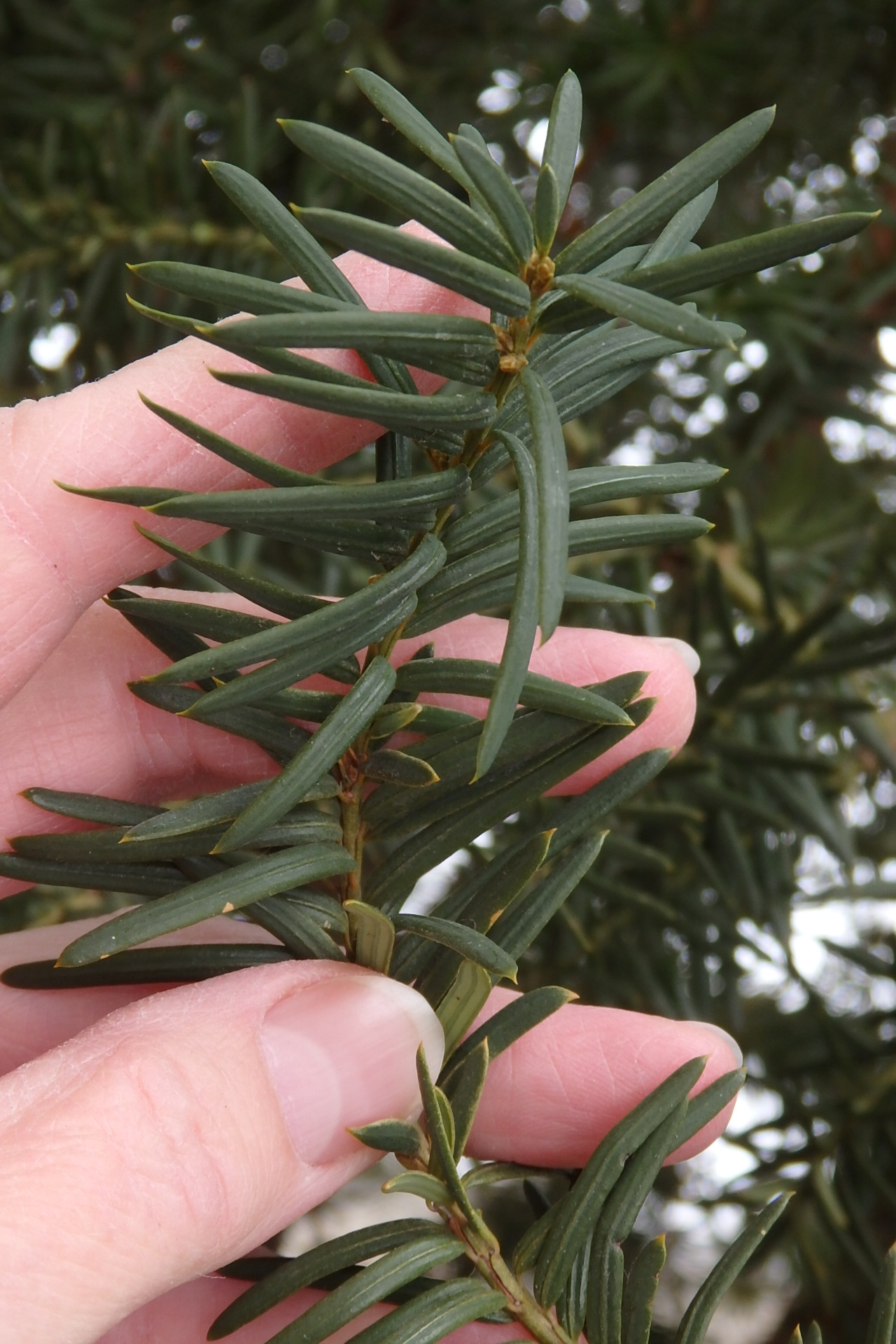Yew in Idaho (White Paper)
Yew in Idaho (White Paper), Idaho Department of Fish and Game, 8 Jan 2019
Yew Species in Idaho and Their Toxicity Risk to Wildlife, Livestock, Pets, and Humans
Yews are very popular in residential and commercial landscapes across Idaho and the US. They are attractive, evergreen shrubs or small trees with bright red, berry-like fruits. They are easy to prune and easy to grow--tolerating shade and a variety of soil types. Many cultivated varieties are available for sale and commonly found in nurseries, garden stores and other plant dealers and distributors. They can be propagated by bare root, container, and cuttings. In Idaho, introduced yews appear to have limited ability to spread through seed production and the seedlings have low vigor. Throughout European and North American history, yews were highly prized for making longbows, and in the 1990s, they were used in synthesis of the cancer drug Taxol. Despite yew’s popularity as an ornamental shrub or tree, they have long been recognized as toxic to livestock and humans.
Yew Species Introduced to Idaho
Four types of yews or their hybrids are commonly found in residential and commercial landscapes across the western US. Japanese yew is the most common type planted in southern Idaho. All four are poisonous:
- Japanese yew (Taxus cuspidata)--native to Japan and neighboring regions; many varieties are widely planted in the US; a shrub or small tree, with some varieties reaching 40 ft tall
- English yew, or European yew (Taxus baccata)--native to Eurasia; many varieties are widely planted in the US; a shrub or small tree, with some varieties reaching 50 ft tall
- Chinese yew (Taxus chinensis, T. sumatrana, T. celebica)--native to Asia; a few varieties of these three species are sometimes planted in the US; a shrub or small tree
- Canadian yew, northern yew (Taxus canadensis)--native to eastern North America; a few varieties are planted in the US; a low-growing shrub to 5 ft tall

Yew Species Native to Idaho
Pacific yew, or western yew (Taxus brevifolia), is found in Idaho from Valley and Washington counties northward. It is a shrub or medium-sized tree reaching 60 ft tall that occurs in wet, shady habitats, and is not typically used in landscaping in southern Idaho--probably because of its high water requirement. Pacific yew contains only trace amounts of toxin and and provides winter forage for moose, elk, and deer. Reports on its toxicity to livestock are mixed.
Identification
Yews can be identified by their short, flat evergreen leaves (1‑3 cm long and 2‑3 mm broad arranged spirally on the stem) and bright red, fleshy, pea-sized fruits that have an opening in the bottom that shows a single hard, brown seed inside. The fruit looks like a berry, but is technically a type of cone called an ‘aril’. This aril is distinctive--no other evergreens in Idaho have a berry-like fruit that doesn’t cover the whole seed. However, arils can be hard to find in the winter, when they have dried and fallen off the shrubs, and arils are absent on male shrubs (only female shrubs produce arils).
Toxicity
Most species of yew contain highly poisonous alkaloids known as taxines, with some variation in the exact formula of the alkaloid between the species. The primary alkaloids in yew are Taxine A and B, a group of cardiac glycoside alkaloids that affect sodium and calcium channels in the heart. Taxine B appears to be much more cardiotoxic than Taxine A.
All parts of ornamental yews except the arils contain the toxic alkaloids. The arils are edible and sweet, but the seed is dangerously poisonous.
The yew seeds are eaten by thrushes, waxwings and other birds, which digest the soft fleshy covering of the seed and disperse the hard seeds undamaged in their droppings.
In mammals, the digestive process can break down the leaves or seed coat and release the taxines into the body. This can have fatal results if yew berries are eaten without removing the seeds first.
Grazing animals, particularly cattle and horses, are also sometimes found dead near yew after eating the leaves. Dried branches can be fatal.
Ornamental yews and their related cultivars are toxic to a variety of animals including horses, cattle, dogs, cats, rabbits, birds, deer, elk, and humans.
Ornamental yews are highly toxic with only a small handful of needles needed to kill horses, elk or dogs.
In Idaho, fatal ingestion of Japanese yew has been documented in elk, moose, deer, and pronghorn, especially in winter
In many areas yews are considered the most toxic tree or shrub. In Idaho, Blaine County passed an ordinance to include Japanese yew, English yew, and Chinese yew and their hybrids on the county noxious weed list.
Children are often treated for poisoning after consuming the fruit of yew shrubs. The seeds resist the effects of digestive enzymes so whether or not seeds were chewed affects risk.
Puppies and adult dogs that chew sticks and other plant material are also at risk for poisoning from this plant.
Signs of yew toxicity include nausea, vomiting, abdominal pain, weakness, pupil dilation, cardiac arrhythmias, hypotension, respiratory distress, seizures, coma, and death. Onset is rapid, usually within 1‑3 hours, though circulatory collapse can occur within 30 minutes in cases involving large amounts of the plant. Death is usually due to heart arrhythmias, heart block, cardiac arrest, circulatory collapse or respiratory failure.
Fatal amounts in adult humans have been estimated at 50 to 100 leaves. The USDA lists 0.1 % of body weight as the toxic level in horses; and 0.5% of body weight as the toxic level in ruminants. In grams per pound body weight, toxicity levels are horse 0.9, cow and sheep 4.5, goat 5.5, pig 1.4, with total fatal dosages in the realm of 100-200 grams for horses, 500 grams for cattle, 75 grams for pigs, 30 grams for dogs, and 30 grams for chickens. The 50% lethal dose (LD50) in mice is 20 mg/kg.
In Idaho, fatal ingestion of Japanese yew or other ornamental yew has been documented in elk, moose, deer, and pronghorn, especially in winter when animals are driven to human habitation by snow depth and yew shrubs are one of the only green plants projecting from the snow. In some locations, winter weather pushes big game animals into urban neighborhoods, increasing the likelihood that yew plants will be encountered.
Reducing the risk of poisoning
To reduce the risk to big game animals homeowners are urged to inventory their property and remove any Japanese or other introduced ornamental yew that might be growing at their residence. These shrubs should be disposed of in a safe, covered landfill. Be aware that dead yews or dry, pruned branches are poisonous. Homeowners can wrap the plants with burlap to prevent access by big game animals until animals have migrated out of the area. Yews resprout from cut stumps, so all large roots need to be dug out unless an herbicide has been used to kill the roots.
More information on poisonous plants, including yew
- Brownie, C.F. 2017. Merck Veterinary Manual. Merck & Co., Inc., Kenilworth, New Jersey. Accessed 8 Jan 2019 at:
- http://www.merckvetmanual.com/toxicology/poisonous-plants/houseplants-and-ornamentals
- Cornell University. 2015. Yew Toxicology in Domestic and Wild Species. in Department of Animal Science - Plants Poisonous to Livestock , Online. Cornell University, Ithaca, New York. Accessed 8 Jan 2019 at:
- Kingsbury, J.M. 1964. Poisonous Plants of the United States and Canada. 3rd Edition. Prentice Hall, Englewood Cliffs, New Jersey.
- Panter, K.E. et al. 2011. Plants Poisonous to Livestock in the Western States. U.S. Department of Agriculture, Agriculture Bulletin No. 415. Agricultural Research Service, Poisonous Plant Research Laboratory, Logan, Utah. Accessed 8 Jan 2019 at:
- Tirmenstein, D.A. 1990. Taxus brevifolia. Fire Effects Information System, Online.
- U.S. Department of Agriculture, Forest Service, Rocky Mountain Research Station, Fire Sciences Laboratory. Accessed 8 Jan 2019 at:
- Wilson et al. 2001. Taxines: a review of the mechanism and toxicity of yew (Taxus spp.) alkaloids. Toxicon 29(2-3): 175-85.
Appendix: Alternative shrubs that can be planted instead of yew
These Idaho native evergreens are non-toxic and can tolerate at least some shade:
- Western swordfern (Polystichum munitum)--shade or part shade, medium water; 2 to 4 ft tall
- Oregon boxleaf (Pachystima myrsinites)--shade or part shade, medium water; 2 to 4 ft tall
- Curl-leaf mountain mahogany (Cercocarpus ledifolius)--part sun or full sun, low water
- Russet buffaloberry (Shepherdia canadensis)--part sun or full sun, moderate to low water
- Oakleaf sumac (Rhus trilobata)--part sun or full sun, low water
- Oregon grape-holly (Berberis aquifolium, Mahonia aquifolium)--full shade to part shade, medium water; may spread
Several other Idaho native shrubs tolerate at least some shade, but are not evergreen:
- Syringa (Philadelphus lewisii)--part shade to full sun, low water; Idaho’s state flower
- Woods rose (Rosa woodsii)--full shade to full sun, low water
- Thimbleberry (Rubus parviflorus)--full shade to part sun, moderate water
- Oceanspray (Holodiscus discolor)--part shade to full sun, moderate water
- Mallow ninebark (Physocarpus malvaceus)--part shade to full sun, low water
- Rocky mountain maple (Acer glabrum)--part shade to full sun, low water
- Golden currant (Ribes aureum)--part shade to full sun, low to moderate water
- Red flowering currant (Ribes sanguineum)--part shade to part sun, low to moderate water
- Common snowberry (Symphoricarpus albus)--full shade to part sun, low water
- Red-twig dogwood (Cornus sericea)--full shade to part sun, medium water; beautiful red branches; a yellow-twig cultivar is also available
- Highbush cranberry/mooseberry (Viburnum edule)--full shade to part shade, medium water
These non-native evergreen shrubs tolerate at least some shade:
- Evergreen huckleberry (Vaccinium ovatum)--shade or part sun, medium to high water
- False cypress (Chamaecyparis spp.)--full shade to full sun depending on variety; medium water
- Arborvitae (Thuja occidentalis)--part sun or sun, medium water; attractive to deer, so might be heavily browsed
More information on alternative species to plant
- Parkinson, H. et al. 2003. Landscaping with Native Plants of the Intermountain Region. Technical Reference 1730-3. Bureau of Land Management, Boise, Idaho. Accessed 8 Jan 2019:

